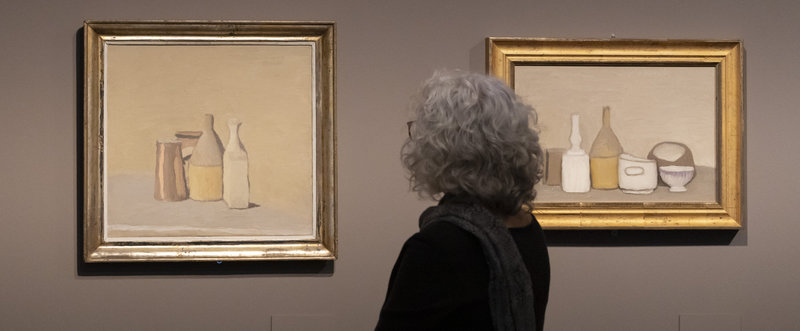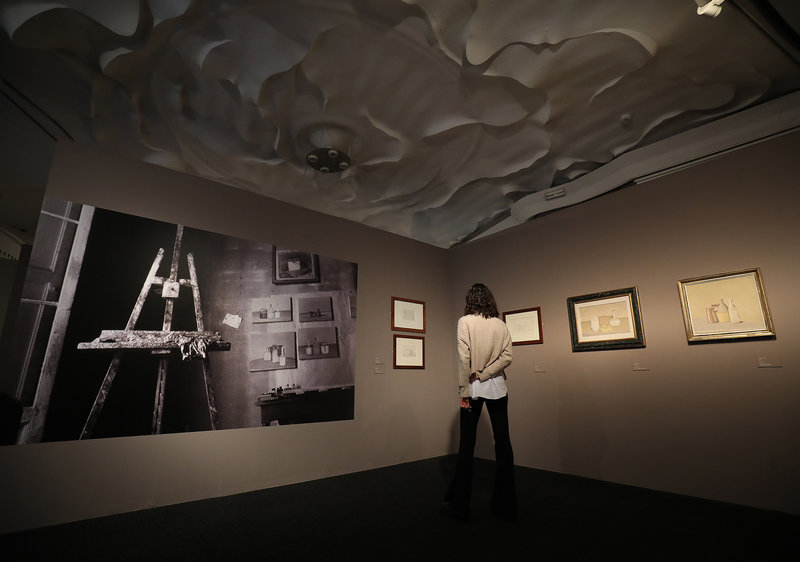The Morandi enigma
After suspending it for two years due to the pandemic, La Pedrera resumes its programme of exhibitions with a retrospective of the great 20th century Italian painter
The artist who lived all his life in Bologna focused on unravelling “the mystery of the simplest things” “MORANDI DIDN’T ALLOW HIMSELF TO BE INFLUENCED BY ANYTHING OR ANYONE, YET WAS A GREAT INFLUENCE HIMSELF”
The only thing that as a painter Giorgio Morandi (July 20, 1890 to June 18, 1964) could be said to truly care about was art for art’s sake. The artist who was born and lived his whole life in the Italian city of Bologna focused above all on unravelling “the mystery of the simplest things”, and he never pretended that his work was at the service of anything else, “neither religion, nor social justice, nor the glory of the nation”. In short, Morandi was something of a free spirit during a period of major artistic revolution and upheaval, and although admired, his legacy has often paid for his singularity with simplistic readings and labels applied to his work. He has even been unflatteringly referred to as the “bottle painter”, as Morandi painted this humble, everyday object obsessively in his workshop in Bologna, which was also his bedroom.
It is the image of this peculiar workshop-bedroom that begins the exhibition Ressonància infinita (Infinite Resonance, until May 22) in La Pedrera, a retrospective of Morandi’s career through 103 of his works taken from a score of collections throughout Europe. The Italian artist also features as the first subject for the resumption of the Catalunya La Pedrera Foundation’s exhibition programme, which has been on hold since the coronavirus pandemic broke out. The Barcelona cultural institution has organised the project in conjunction with the Mapfre Foundation, which unveiled the exhibition last autumn at its headquarters in Madrid. According to the director of La Pedrera, Marta Lacambra, the “close involvement” with other local, national and international organisations will become a major feature of the Casa Milà exhibition programme in the future.
A life of seclusion
Apart from some visits to see Antoni Gaudí’s building in the heart of Barcelona, things have been quiet for the past two years in La Pedrera, and which now focuses on the work of an artist who preferred to live in quiet seclusion. His home in Bologna, which he shared with his mother and unmarried sisters, was his entire world. The only time he would escape would be in the summer months, when he would stay in nearby Grizzana, where he painted some landscapes that feature as a discordant note in an artistic career almost exclusively given over to still lifes. And what’s more, always the same still life subjects – the aforementioned bottles, but also vases and bowls.
Morandi would spend years thinking about each of his paintings, but take only hours to actually paint it. “Morandi’s quest for repetition is an attempt to get to the heart of the matter. The range of subjects is very small, but there are constant variations. And it is through this monotony that his painting conveys a sense of eternity. It is a window that opens to the soul,” says Daniela Ferrari, the co-curator of the exhibition.
Beatrice Avanzi, the other art expert who has worked with Ferrari on setting up this international project, points out that the enigma of Morandi is very much determined by his isolation. “He chose a difficult path, one that was autonomous and unique, far from the trends and fashions of the time. Although that is not to say that he didn’t know about them.”
In fact, at the beginning of his career he dabbled in some of the leading art styles of the avant-garde, such as Cubism, Futurism and Metaphysical Painting. The La Pedrera exhibition gives a taste of these paintings that emulated the groundbreaking first steps of the early champions of artistic modernity, a rehearsal stage that Morandi was not comfortable with. Perhaps the proof of this is that during the First World War he destroyed many of these early works.
A great influence
Morandi’s choice as an artist would end up being singular. “He does not allow himself to be influenced by anything or anyone, but on the contrary, he did have a great influence on later generations, who saw him as a benchmark of spatial and chromatic harmony, a beacon of pure painting. Morandi is an absolute master of painting,” remark the curators, who work as conservators at the Museum of Modern and Contemporary Art of Trento and Rovereto, and who have also brought with them to the La Pedrera exhibition one of the seven self-portraits Morandi painted in his life.
The human figure is the great absentee in his work, which can be described as refined, silent and ultimately unclassifiable. Many have tried to give it a name, and it has been referred to as classical, romantic, existentialist, and abstract. “There is nothing more abstract than reality,” he believed, say the curators. However, one art critic described Morandi’s paintings as a type of “intimate diary” and perhaps that is the most accurate description.
feature art




